Introduction to Probability - Probability Rules: General Addition Rule
The Addition Rule for finding P(A or B) in the special case when A and B are disjoint events - that is when the events cannot happen together → P(A and B)= 0.
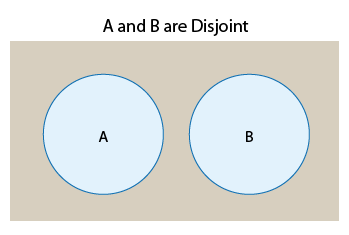
In this special case P(A or B) refers to the probability of either event A occurring or event B occurring and we said that P(A or B)=P(A) + P(B). Visually, in the Venn diagram above we can clearly see that P(A or B), represented by the total blue area, can be found by adding the areas of the two circles, one representing P(A) and the other P(B).
As we mentioned above the case when A and B are disjoint is a special case and in many situations the events are not disjoint -they can occur at the same time.
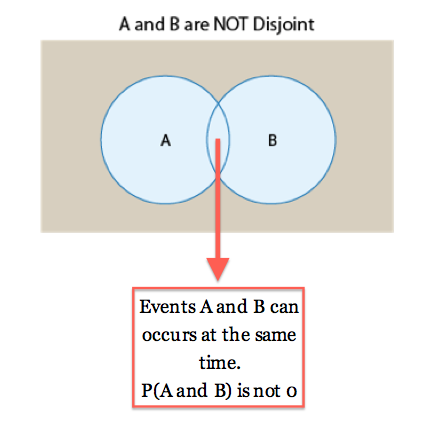
P(A or B) is represented by the total blue area which in this case looks different. In this case this area includes an overlap between the two circles which corresponds to the probability that both events A and B occur. This difference has an important implication to the meaning of P(A or B) when A and B are not disjoint.
When A and B are not disjoint P(A or B) means P(A occurs or B occurs or both events occur).
Example - Probability Rules: General Addition Rule
It is vital that a certain document reach its destination within one day. To maximize the chances of on-time delivery, two copies of the document are sent using two services, service A and service B. It is known that the probabilities of on-time delivery are:
0.90 for service A (P(A) = 0.90)
0.80 for service B (P(B) = 0.80)
0.75 for both services being on time (P(A and B) = 0.75)
(Note that A and B are not disjoint. They can happen together with probability 0.75.)
The Venn diagrams below illustrate the probabilities P(A), P(B), and P(A and B) [not drawn to scale]:
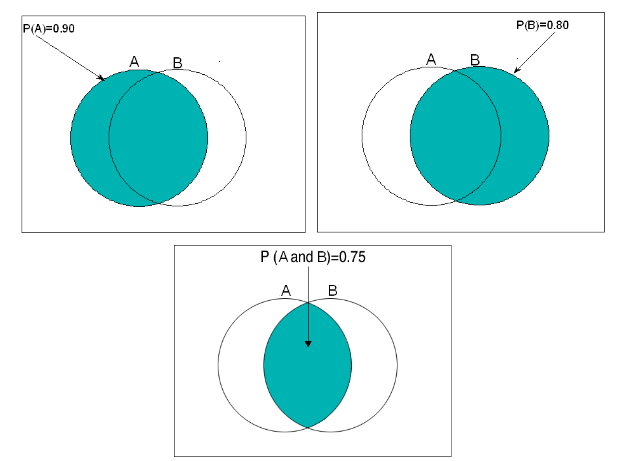
In the context of this problem, the obvious question of interest is:
What is the probability of on-time delivery of the document using this strategy (of sending it via both services)?
The document will reach its destination on time as long as it is delivered on time by service A or by service B or by both services. In other words, when event A occurs or event B occurs or both occur. so....
P(on time delivery using this strategy)= P(A or B), which is represented the by the shaded region in the diagram below:
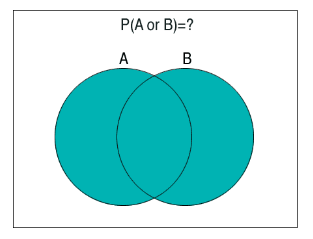
We can now use the three Venn diagrams representing P(A), P(B) and P(A and B) to see that we can find P(A or B) by:
adding P(A) (represented by the left circle) and P(B) (represented by the right circle), then subtracting P(A and B) (represented by the overlap), since we included it twice, once as part of P(A) and once as part of P(B).
This is shown in the following image:

If we apply this to our example, we find that:
P(A or B)= P(on-time delivery using this strategy)= 0.90 + 0.80 - 0.75 = 0.95.
So our strategy of using two delivery services increases our probability of on-time delivery to 0.95.
The General Addition Rule
For any 2 events A and B, P(A or B) = P(A) + P(B) - P(A and B).
As we mentioned above P(A or B)= P(A occurs or B occurs or both occur). Another way to interpret P(A or B) is therefore P(At least one of the two events occur).
- Explanation :
P(at least one stop) = P(A or B). Since the events are not disjoint, we must use the General Addition Rule. P(A or B) = 0.45 + 0.30 – 0.20 = 0.55
- Explanation :
P(admitted to at least one college) = P(A or B). Since the events are not disjoint, we must use the General Addition Rule. P(A or B) = 0.10 + 0.75 – 0.05 = 0.80
Scenario: Smoke Detectors - General Additive rule
Q. A homeowner has two smoke detector alarms installed, one in the dining room (adjacent to the kitchen) and one in an upstairs bedroom (above the kitchen). If cooking produces smoke in the kitchen, the probability of setting off the dining room alarm (D) is 0.95. The probability of setting off the bedroom alarm (B) is 0.40. The two alarms detect smoke independently of each other. If there is smoke in the kitchen, what is the probability that the smoke will be detected and will set off an alarm?
Let's first understand what probability we need to find: The smoke from the fire is detected if it sets off the dining room alarm (D) or the bedroom alarm (B) or both, and therefore P(smoke is detected) = P(D or B), which is the probability we need to find. To that end, we are given a few pieces of information. Let's summarize them:
P(D) = 0.95
P(B) = 0.4
Unlike the previous examples, in which P(A and B) was simply given, here we have a different piece of information: "The two alarms detect smoke independently of each other." In other words, instead of being given P(D and B), we are given the fact that D and B are independent.
Q. Explain why we have enough information to find P(D and B); then find P(D and B).
Since D and B are independent, we can use the Multiplication Rule for Independent Events (rule 5) as follows: .
P(D and B) = P(D) * P(B) = 0.95 * 0.4 = 0.38. In other words, if there is a fire, there is a 38% chance that both alarms will go off
Q. Now use the information you are given and the General Addition Rule to find the desired probability, P(smoke is detected).
P(smoke is detected) = P(D or B)
= P(D) + P(B) - P(D and B)
= 0.95 + 0.40 - 0.38
= 0.97
Scenario: Shared Birth Month
Q. What is the probability that at least one of the next two strangers you meet shares your birth month? For this problem assume birth months are equally likely, so the probability of being born in a given month is 1/12 (about 0.083). Let A = first stranger shares your birth month Let B = second stranger shares your birth month Assume that meeting two strangers is like randomly selecting two people from a large population
- Explanation :
The events are independent because the two strangers are randomly selected from a large population. So the probability that the first stranger shares your birth month does not affect the probability that the second stranger shares your birth month.
- Explanation :
P(at least one stranger shares your birth month) = P(A or B). Since the events are not disjoint, we must use the General Addition Rule. Since the events are independent, P(A and B) = P(A)*P(B). So P(A or B) = 1/12 + 1/12 – (1/12)(1/12) = 0.1597 or about 0.16.
Probability Rules: Probability Tables
In our delivery example, there are two categorical variables of interest in the background:
On-time delivery by service A (yes/no)
On-time delivery by service B (yes/no)
Since each of the two has two possible values (yes/no), there are four possible combinations altogether, which correspond to the four possible outcomes of using the two services.
While the Venn diagrams were great to visualize the General Addition Rule, in cases like these it is much easier to display the information in and work with a two-way table of probabilities, much as we examined the relationship between two categorical variables in the Exploratory Data Analysis section.
How do we build a two-way table of probabilities?
The probability of on-time delivery by service A is given to be .90.
The probability of on-time delivery by service B is given to be .80, and the probability of on-time delivery by both service A and service B is given to be .75.
Note that probabilities that involve just one of the services, like probability of A or probability of B, sit in the margins of the probability table and probabilities that involve both services, like probability of A and B sit in the body of the table.
Next we complete the margin by simply applying the compliment rule.
If the probability of a is .90, then the probability of not A must be .10.
If the probability of B is .80, then the probability of not B must be .20.
Note that both the row totals and column totals sum up to one.
Next, we start completing the remaining three cells in the body of the table by making sure that we get the right totals.
The probability of A and not B (the probability of on-time delivery just by service A and not by service B) must be .15 since the total of this row is .90.
Similarly, the probability of B and not A (the probability of on-time delivery just by service B and not by service A) must be .05 since the total of this column is .80.
Finally, the remaining cell, representing probability of not A and not B (the probability that the document will not reach its destination on time since both services failed to deliver it on time) must also be .05 to fit the totals.
Here is the completed two-way table of probabilities for the delivery example.
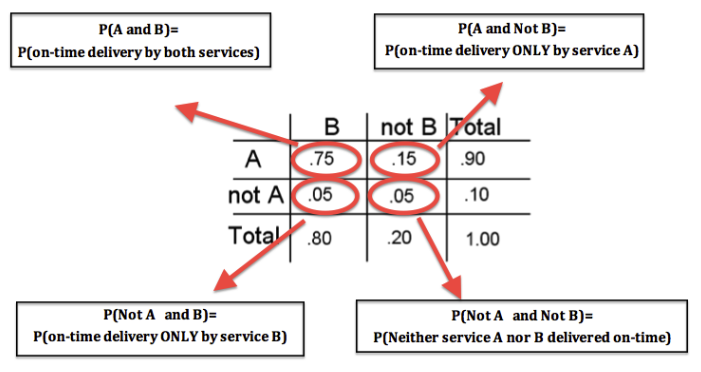
Comment
A common mistake is to confuse between: P(A)=P(event A occurs) and P(A and Not B)=P(ONLY event A occurs)[and similarly, between P(B)=P(event B occurs) and P(Not A and B)=P(only event B occurs)].
Looking at the probability table is a great way to clear-up this confusion:
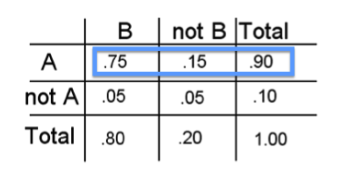
P(A) = 0.90 means that in 90% of the cases when service A is used, it delivers the document on time.
These cases of on-time delivery by service A can be decomposed into two sub-cases:
P(A and B) =0.75 → 75% of the time the document is delivered on time also by service B (i.e., the document is delivered on time by both services)
P(A and Not B) = 0.15 → 15% of the time the document is not delivered on time by service B (i.e., delivered on time only by service A).
Similarly,
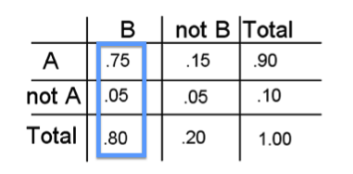
P(B) = 0.80 means that in 80% of the cases when service B is used, it delivers the document on time.
These cases of on-time delivery by service B can be decomposed into two sub-cases:
P(A and B) = 0.75 → 75% of the time the document is delivered on time also by service A (i.e., the document is delivered on time by both services)
P(Not A and B) = 0.05 → 5% of the time the document is not delivered on time by service A (i.e., delivered on time only by service B).
Probability Rules: Using Tables to Solve Problems
Let's go back to our delivery example and see how we can "lift" probabilities from the two-way probability table in order to answer the question posed in that example and related questions. Here is the table again:
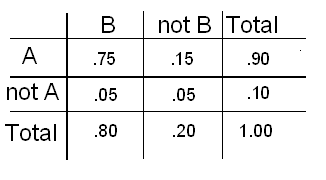
What is the probability of on-time delivery of the document using the two services strategy?
In other words, what is P(A or B)?
We can use the table in two ways:
(i) We can simply lift P(A), P(B) and P(A and B) from the table as shown in the table below and use the General Addition Rule to get 0.95. as we did before: P(A or B) = P(A) + P(B) - P(A and B) = 0.90 + 0.80 - 0.75 = 0.95.
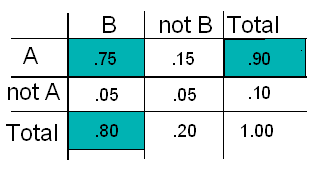
(ii) Another way to use the table is to use the fact that in probability, "A or B" actually means A or B or both. The corresponding cells for these three options are shaded below and are 0.15 (only A), 0.05 (only B), and 0.75 (both). We can add these up to get: P(A or B) = 0.95.
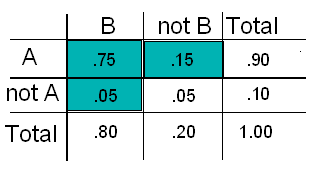
Q. What is the probability of on-time delivery by exactly one service?
On-time delivery by exactly one service occurs if the document arrives on-time by service A and not B, or by service B and not A.
The probabilities of these two possibilities are represented by the shaded cells in the table below, and are 0.15 and 0.05 respectively.
Therefore, P(on-time delivery by exactly one service) = 0.15 + 0.05 = 0.20
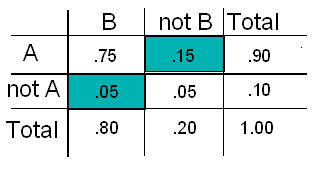
Q. What is the probability that the document will not get to its destination on time?
This would be the occurrence of the event "not A and not B," whose probability is 0.05, as shown in the table:
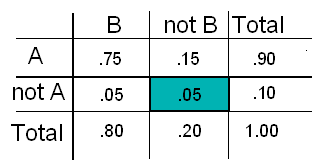
Q. Candace is applying to two colleges, Ross College and the more prestigious Cirus College. The probability table below represents her belief about whether she will be accepted. We use the following notation:
R—the event of being accepted to Ross College
C—the event of being accepted to Cirus College.
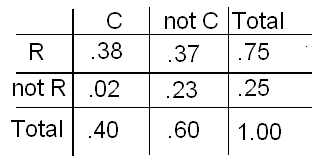
- Explanation :
P(R and C) = 0.38 is the probability that she is accepted by Ross and by Cirus.
- Explanation :
The probability that she will only get into Ross is P(R and ‘not C’)
- Explanation :
The probability that she will only get into Cirus is P(‘not R’ and C)
- Explanation :
If Candace is accepted to exactly one college, then she is accepted to only Ross or only Cirus. These are disjoint events, so P(accepted to exactly one college) = P(R and ‘not C) + P(‘not R’ and C) = 0.37 + 0.02 = 0.39.
- Explanation :
Since we are using a probability table, the most obvious approach is to think of the sample space of the event “accepted by at least one of the colleges” as {R and C, R and ’not C’, ‘not R’ and C}, which are disjoint events. So add 0.38 + 0.37 + 0.02 = 0.77. Another strategy views “accepted by at least one of the colleges” as the complement of the event (‘not R’ and ‘not C’). Using the complement rule, 1 – P(‘not R’ and ‘not C’) = 1 – 0.23 = 0.77. You can also use the General Addition Rule: P(R) + P(C) – P(R and C) = 0.75 + 0.40 – 0.38 = 0.77
Summarize
The Complement Rule states that P(not A) = 1 - P(A) or when rearranged P(A) = 1 - P(not A).
The Complement Rule is very useful when we need to find probabilities of the sort: P(At least one of several events occur) which is hard to calculate. In this case we apply the Complement Rule: P(At least one of several events occur) = 1 - P(None of the events occur), since P(None of the events occur) is usually much easier to find.
The General Addition Rule states that for any two events, P(A or B) = P(A) + P(B) - P(A and B), where, by P(A or B) we mean P(A occurs or B occurs or both).
In the special case when A, B are disjoint events (which means that P(A and B)=0) The general addition rule becomes P(A or B)=P(A)+P(B) which we called the Addition Rule for Disjoint Events. Beware of wrongly using the Additional Rule for Disjoint events when the events are not disjoint.
When we want to find P(A and B), we can use the Multiplication Rule, but so far we've only learned the restricted version of this rule—the Multiplication Rule for Independent Events. Events are independent if the occurrence of one of the events has no effect on the probability of the other occurring, in which case: P(A and B) = P(A) * P(B).
The Additional Rule for Disjoint Events can be naturally extended to more than two events. In other words, if events A, B, and C are disjoint then P(A or B or C)=P(A)+P(B)+P(C). Similarly, the Multiplication Rule for Independent Events can be naturally extended to more than two independent events. In other words, if events A, B, and C are independent, then: P(A and B and C)=P(A)*P(B)*P(C). The same is true for four, five etc. disjoint/independent events.
When there are two categorical variables in the background, each with two possible values, a two-way probability table is a quick and easy way to display the probabilities associated with the 4 possible combinations.